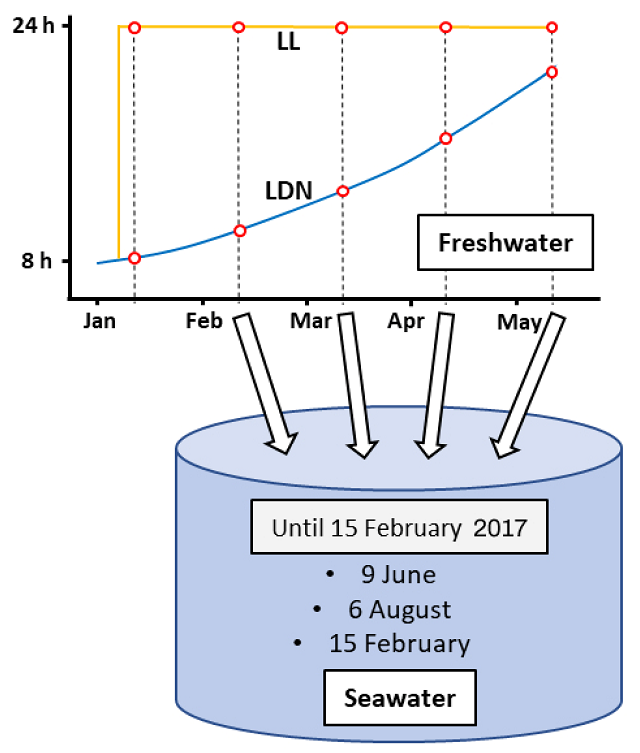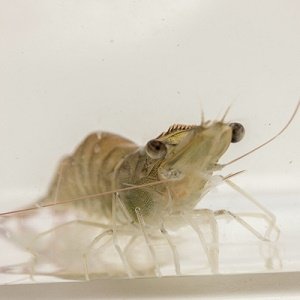
A pivotal phase in the salmon farming industry is the smoltification process, during which juvenile salmon prepare for their transition from the freshwater environment to seawater. Despite the critical importance of this stage, industry experts lack consensus on the best protocols for producing high-quality smolts.
To shed light on this subject, a study conducted by scientists from the University of Bergen, Akvaplan-Niva, and Bergen College University explores the impact of photoperiod regimes in freshwater and the timing of transfer to seawater on smolt development and subsequent growth during commercial production.
Photoperiod Regimes in Freshwater
The study investigates the effects of two photoperiod regimes in freshwater: continuous light (LL) and natural photoperiod (LDN). These regimes were combined with four different transfer times to seawater (February, March, April, and May) to observe their influence on smolt development.
Surprisingly, the study revealed that the photoperiod treatments had only a minimal effect on smoltification and growth in freshwater.
“This is evident from the lack of significant differences in body weight between the photoperiod groups at any sampling point. However, the significant increase observed in body weight over time in LL but not in LDN indicates higher growth rates in response to early exposure to continuous light,” reported the researchers.
In contrast, the predominant factor influencing smolt development during this phase was water temperature. Low water temperatures during the freshwater period significantly impacted smolt growth. This finding underscores the need for precise temperature control and management in salmon aquaculture systems.
Seawater Growth and Compensatory Growth
During the transition to seawater, the study unveiled an interesting dynamic. While some groups experienced a growth delay during their time in freshwater, they demonstrated a compensatory growth effect in seawater. This compensatory growth was more pronounced in groups that initially had a slower growth rate in freshwater.
Interestingly, there were no significant differences in the final body weight of the salmon across the various treatments, suggesting that compensatory growth in seawater can offset any delays experienced in freshwater.
Stay Always Informed
Join our communities to instantly receive the most important news, reports, and analysis from the aquaculture industry.
This observation holds significant implications for the industry, indicating that even if smolts experience growth delays in freshwater, they can reach similar body weights when transferred to seawater.
The Role of Smolt Quality
The study also identified a link between the weight at slaughter and the weight at the time of transfer to seawater. This link was particularly significant in groups with lower smolt quality, notably those subjected to the LL-Feb, LDN-Feb, and LDN-Mar treatments. Larger individuals appeared to perform better in the saline environment, possibly due to their greater osmoregulatory capacity.
In contrast, smaller smolts may have experienced higher osmotic stress in seawater, which hindered their performance. As smolt quality improved in subsequent transfer groups, the size effect on seawater performance diminished.
This suggests that the industry could benefit from transferring larger smolts to seawater, especially when concerns exist regarding suboptimal seawater tolerance.
Conclusion
The findings of the study emphasize the need for a comprehensive understanding of smolt development and performance during the transition to seawater. Future research should focus on exploring the possible long-term effects of freshwater-rearing regimes on smolt performance in the seawater phase.
In summary, optimizing the success of Atlantic salmon aquaculture involves not only considering photoperiod regimes and transfer times but also recognizing the importance of temperature control and smolt quality. By transferring larger smolts to seawater, the industry can enhance its overall productivity, particularly when dealing with concerns about seawater tolerance. This study serves as a valuable step toward improving the management of smolt development and, ultimately, enhancing the sustainability and efficiency of Atlantic salmon aquaculture.
The study was funded by Sævareid Fiskeanlegg AS (5645, Hordaland, Norway).
Reference (open access)
Pino Martinez, E.; Imsland, A.K.D.; Hosfeld, A.-C.D.; Handeland, S.O. Effect of Photoperiod and Transfer Time on Atlantic Salmon Smolt Quality and Growth in Freshwater and Seawater Aquaculture Systems. Fishes 2023, 8, 212. https://doi.org/10.3390/fishes8040212
Editor at the digital magazine AquaHoy. He holds a degree in Aquaculture Biology from the National University of Santa (UNS) and a Master’s degree in Science and Innovation Management from the Polytechnic University of Valencia, with postgraduate diplomas in Business Innovation and Innovation Management. He possesses extensive experience in the aquaculture and fisheries sector, having led the Fisheries Innovation Unit of the National Program for Innovation in Fisheries and Aquaculture (PNIPA). He has served as a senior consultant in technology watch, an innovation project formulator and advisor, and a lecturer at UNS. He is a member of the Peruvian College of Biologists and was recognized by the World Aquaculture Society (WAS) in 2016 for his contribution to aquaculture.




